How to Embed Screenshots and Other Files with My Personal Knowledgebase
50+ years in computers
EE FELLOW 2017 — first ever recipient of Fellow award
MVE 2015,2016,2018
CERTIFIED GOLD EXPERT
DISTINGUISHED EXPERT
EE FELLOW 2017 — first ever recipient of Fellow award
MVE 2015,2016,2018
CERTIFIED GOLD EXPERT
DISTINGUISHED EXPERT
Published:
Browse All Articles > How to Embed Screenshots and Other Files with My Personal Knowledgebase
During the review/publication process for one of my previous articles, How to Embed Screenshots in Posts, the Page Editor, lherrou, brought to my attention a new EE feature – the ability to upload files into My Personal Knowledgebase (MyPKb). Furthermore, when those uploaded files are images, they may be embedded in questions, answers, and articles. In fact, all of the screenshots in this article were embedded from MyPKb. Beyond just images, you may embed other file types, which I'll discuss toward the end of the article.
I considered adding a section about this methodology to my previous article, but decided that it is worthy of its own article. In addition, an objective was to keep the previous article brief.
This article assumes that you already know how to capture screenshots into image files (BMP, GIF, JPG, PNG, etc.) via techniques such as the PrintScreen key (captures all monitors), Alt-PrintScreen (captures just the focus window), the Snipping Tool (built into W7 and W8), Snagit (a popular commercial product from TechSmith), Greenshot (a free, open source product published under the GNU GPL), etc. If you don't know how to capture screenshots, please read my previous article, as well as the two articles it references in its first paragraph.
So, you now have an image file that you'd like to embed in a post (or article). Here are the steps to do this utilizing MyPKb:
(1) On the right side of any question (including a New Question), click the Workspace tab (to the left of the Profile tab):
![01-Workspace.jpg]()
(2) Click the My Personal Knowledgebase item, which will drop down two choices – All Items and Questions – assuming you have saved some questions but have never uploaded a file. If you do have files in MyPKb, there will be a third choice – Files:
![02-MyPKb-drop-down-with-files.jpg]()
(3) In any case, click the View my Personal Knowledgebase link:
![03-MyPKb-drop-down-before-files.jpg]()
This will bring up MyPKb with your saved questions (and files, if you have any). There are two ways to view the entries – Detail View and List View – and each view gives you the choice of showing 10, 25, 50, 100, or 200 entries at a time:
![04-MyPKb-Detail-View.jpg]()
![05-MyPKb-List-View.jpg]()
(4) Click the Add button to upload a file:
![06-MyPKb-Add-button.jpg]()
(5) The default is to add a Link, so click the Add new drop-down and select File, which gives this:
![07-Add-New-File-to-MyPKb.jpg]()
Note the warning, "You are limited to 500 total items in your Personal Knowledgebase. You currently have 490 entries." I'll discuss this later in the article.
(6) Click the Browse button, navigate to and select the file, click the Upload File button, and you'll see this:
![08-Add-Entry-to-MyPKb.jpg]() (7) Enter Notes and Labels. A comma terminates each label and places it in the box:
(7) Enter Notes and Labels. A comma terminates each label and places it in the box:
![09-Labels.jpg]()
Both are optional, but very good ideas, as the MyPKb search feature is excellent, able to search rapidly on Notes and Labels:
![10-Search.jpg]()
(8) Once an item is in MyPKb, there are three Actions you may perform on it via icons on the right side – copy its URL, view/download it, edit its Title, Description, Notes, Labels:
![11-Actions.jpg]()
(9) There are also two actions that you may perform on a group of selected items via icons on the upper left – Delete and Add Label:
![12-Actions-on-multiple-entries.jpg]()
(10) Now that your screenshot is in MyPKb, it's time to embed it in a post (or article). In previous versions of the EE website, the Post a Comment dialog had just the Attach File action at the bottom; now it has an additional action there: Attach File from Personal Knowledgebase. Clicking on that brings up this:
![13-Attach-File-from-Pkb.jpg]() (11) Clicking on the drop-down arrow shows all of the files in MyPKb:
(11) Clicking on the drop-down arrow shows all of the files in MyPKb:
![14-Select-file-from-MyPKb.jpg]()
(12) Selecting one of those files will show it as an attached file and provide both Embed and Remove actions. Clicking on Embed will generate the code necessary to embed it:
![15-Embed-from-MyPKb.jpg]()
The image is now embedded! This technique means that a single image/file in MyPKb may be used in any number of posts (and/or articles) at EE.
An embedded image shows a thumbnail of the image, as can be seen in all of the embedded images in this article. The thumbnail is large and often quite readable, but if a larger view is required, clicking on the thumbnail opens a full-size image in a new browser tab.
An important feature of a file in MyPKb is that it has a unique URL. So if you prefer not to have an embedded image, you may use its URL instead. For example, the first image embedded in this article is the Workspace screenshot. But instead of embedding it, I could have referred to it like this.
Another important feature is that a file attached to a post (or article) will remain accessible even if the file is deleted from MyPKb. This is made clear in the confirmation dialog when you delete an entry:
![16-Confirm-deletion.jpg]()
Although this article focuses on uploading image files to MyPKb for the purpose of embedding screenshots in posts (and articles), it's important to note that it is possible to upload many other file types to MyPKb and embed them in EE content. The list of allowable file types for uploading is documented here. When you attempt to upload a disallowed file type, you will see this:
![19-File-Extension-not-allowed.jpg]()
If there's a file type not on the list which you're interested in being able to upload, there's a mechanism to request the addition of a file type to EE's list of allowed extensions.
Uploading and embedding/linking-to other file types works in the same way as image files, which was documented throughout this article. Here's an example of an embedded PDF file that contains documentation for a product that I recommend often in my answers to questions at EE:
IrfanView-4.35-command-line-options.pdf
Likewise, here's an example of a linked-to Excel spreadsheet that I created for an article previously published at EE.
Earlier in this article, I mentioned the warning, "You are limited to 500 total items in your Personal Knowledgebase. You currently have 490 entries." Indeed, here's what happened when I tried to add item #501:
![17-Reached-500-limit.jpg]()
I mentioned this to Page Editor, lherrou, pointing out that the 500-entry limit reduced the value of MyPKb significantly. As a member who participates in many questions, I've been saving them in MyPKb for quite a while to take advantage of its powerful search feature – it is extremely valuable to be able to search questions that I participated in previously. So lherrou was kind enough to bring this issue to the attention of EE's website developers. As it turns out, the search function was the reason for the 500-entry limit. The developers want to keep the search fast (and it is!), but they were initially concerned that going beyond 500 would be problematic. However, I am pleased to report that the developers studied the issue and concluded that fast performance could be maintained – even with 50,000 entries! Here's a screenshot showing 520 items in MyPKb:
![18-MyPKb-now-allows-50-000-entries.jpg]()
So we now have a 50,000-entry MyPKb! I believe this dramatically improves its value.
A huge thanks to lherrou for escalating this issue and to the website developers for implementing a solution. This is an excellent example of a member making a recommendation for a site improvement and EE taking it to heart. Of course, not all recommendations will be implemented, but it's gratifying to know that EE pays attention to such requests and is clearly interested in improving the site for its members.
If you find this article to be helpful, please click the thumbs-up icon below. This lets me know what is valuable for EE members and provides direction for future articles. Thanks very much! Regards, Joe
I considered adding a section about this methodology to my previous article, but decided that it is worthy of its own article. In addition, an objective was to keep the previous article brief.
This article assumes that you already know how to capture screenshots into image files (BMP, GIF, JPG, PNG, etc.) via techniques such as the PrintScreen key (captures all monitors), Alt-PrintScreen (captures just the focus window), the Snipping Tool (built into W7 and W8), Snagit (a popular commercial product from TechSmith), Greenshot (a free, open source product published under the GNU GPL), etc. If you don't know how to capture screenshots, please read my previous article, as well as the two articles it references in its first paragraph.
So, you now have an image file that you'd like to embed in a post (or article). Here are the steps to do this utilizing MyPKb:
(1) On the right side of any question (including a New Question), click the Workspace tab (to the left of the Profile tab):

(2) Click the My Personal Knowledgebase item, which will drop down two choices – All Items and Questions – assuming you have saved some questions but have never uploaded a file. If you do have files in MyPKb, there will be a third choice – Files:
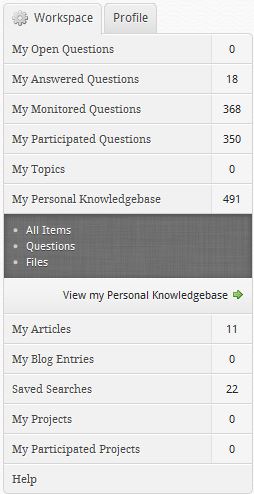
(3) In any case, click the View my Personal Knowledgebase link:
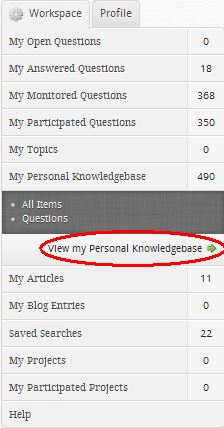
This will bring up MyPKb with your saved questions (and files, if you have any). There are two ways to view the entries – Detail View and List View – and each view gives you the choice of showing 10, 25, 50, 100, or 200 entries at a time:
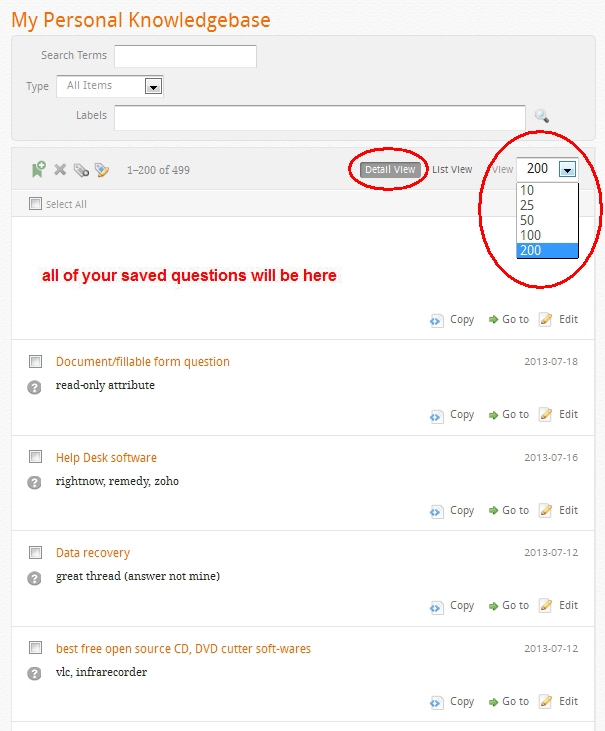
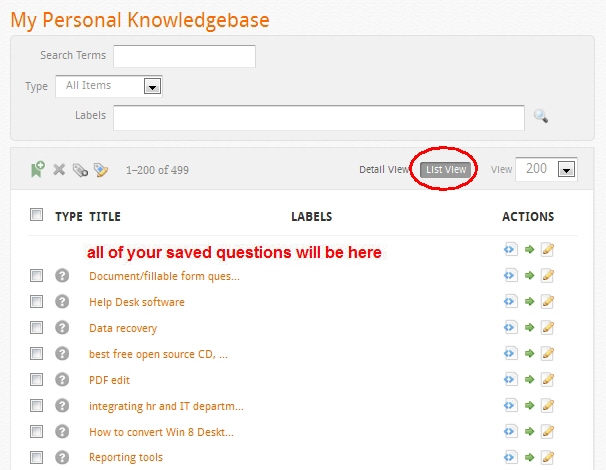
(4) Click the Add button to upload a file:

(5) The default is to add a Link, so click the Add new drop-down and select File, which gives this:

Note the warning, "You are limited to 500 total items in your Personal Knowledgebase. You currently have 490 entries." I'll discuss this later in the article.
(6) Click the Browse button, navigate to and select the file, click the Upload File button, and you'll see this:
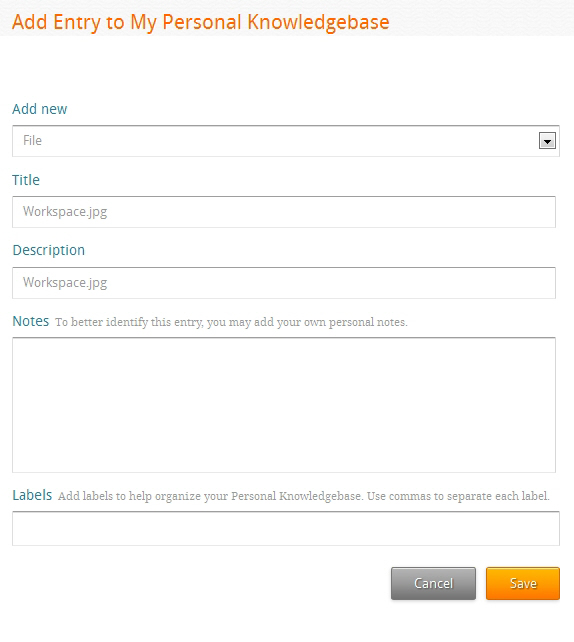 (7) Enter Notes and Labels. A comma terminates each label and places it in the box:
(7) Enter Notes and Labels. A comma terminates each label and places it in the box:

Both are optional, but very good ideas, as the MyPKb search feature is excellent, able to search rapidly on Notes and Labels:

(8) Once an item is in MyPKb, there are three Actions you may perform on it via icons on the right side – copy its URL, view/download it, edit its Title, Description, Notes, Labels:
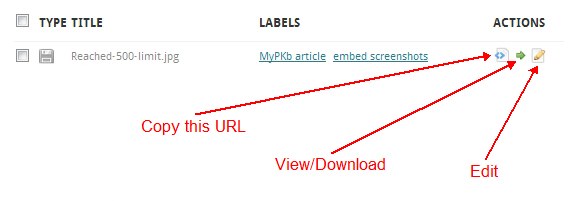
(9) There are also two actions that you may perform on a group of selected items via icons on the upper left – Delete and Add Label:
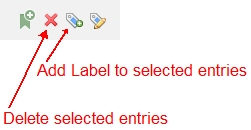
(10) Now that your screenshot is in MyPKb, it's time to embed it in a post (or article). In previous versions of the EE website, the Post a Comment dialog had just the Attach File action at the bottom; now it has an additional action there: Attach File from Personal Knowledgebase. Clicking on that brings up this:
 (11) Clicking on the drop-down arrow shows all of the files in MyPKb:
(11) Clicking on the drop-down arrow shows all of the files in MyPKb:
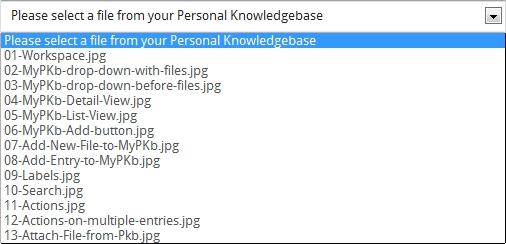
(12) Selecting one of those files will show it as an attached file and provide both Embed and Remove actions. Clicking on Embed will generate the code necessary to embed it:
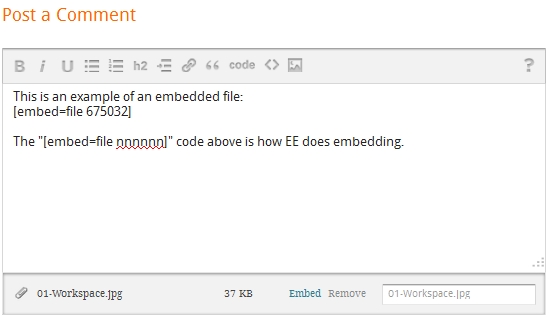
The image is now embedded! This technique means that a single image/file in MyPKb may be used in any number of posts (and/or articles) at EE.
An embedded image shows a thumbnail of the image, as can be seen in all of the embedded images in this article. The thumbnail is large and often quite readable, but if a larger view is required, clicking on the thumbnail opens a full-size image in a new browser tab.
An important feature of a file in MyPKb is that it has a unique URL. So if you prefer not to have an embedded image, you may use its URL instead. For example, the first image embedded in this article is the Workspace screenshot. But instead of embedding it, I could have referred to it like this.
Another important feature is that a file attached to a post (or article) will remain accessible even if the file is deleted from MyPKb. This is made clear in the confirmation dialog when you delete an entry:
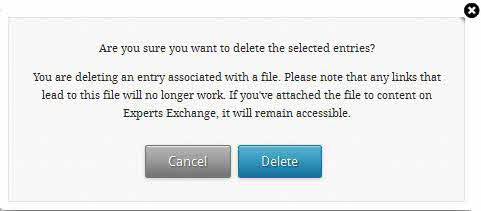
Although this article focuses on uploading image files to MyPKb for the purpose of embedding screenshots in posts (and articles), it's important to note that it is possible to upload many other file types to MyPKb and embed them in EE content. The list of allowable file types for uploading is documented here. When you attempt to upload a disallowed file type, you will see this:

If there's a file type not on the list which you're interested in being able to upload, there's a mechanism to request the addition of a file type to EE's list of allowed extensions.
Uploading and embedding/linking-to other file types works in the same way as image files, which was documented throughout this article. Here's an example of an embedded PDF file that contains documentation for a product that I recommend often in my answers to questions at EE:
IrfanView-4.35-command-line-options.pdf
Likewise, here's an example of a linked-to Excel spreadsheet that I created for an article previously published at EE.
Earlier in this article, I mentioned the warning, "You are limited to 500 total items in your Personal Knowledgebase. You currently have 490 entries." Indeed, here's what happened when I tried to add item #501:

I mentioned this to Page Editor, lherrou, pointing out that the 500-entry limit reduced the value of MyPKb significantly. As a member who participates in many questions, I've been saving them in MyPKb for quite a while to take advantage of its powerful search feature – it is extremely valuable to be able to search questions that I participated in previously. So lherrou was kind enough to bring this issue to the attention of EE's website developers. As it turns out, the search function was the reason for the 500-entry limit. The developers want to keep the search fast (and it is!), but they were initially concerned that going beyond 500 would be problematic. However, I am pleased to report that the developers studied the issue and concluded that fast performance could be maintained – even with 50,000 entries! Here's a screenshot showing 520 items in MyPKb:

So we now have a 50,000-entry MyPKb! I believe this dramatically improves its value.
A huge thanks to lherrou for escalating this issue and to the website developers for implementing a solution. This is an excellent example of a member making a recommendation for a site improvement and EE taking it to heart. Of course, not all recommendations will be implemented, but it's gratifying to know that EE pays attention to such requests and is clearly interested in improving the site for its members.
If you find this article to be helpful, please click the thumbs-up icon below. This lets me know what is valuable for EE members and provides direction for future articles. Thanks very much! Regards, Joe
Have a question about something in this article? You can receive help directly from the article author. Sign up for a free trial to get started.


Comments (4)
Commented:
Author
Commented:Thanks for the kind words – I really appreciate it! I'm glad you found the article helpful. Regards, Joe
Commented:
Author
Commented: